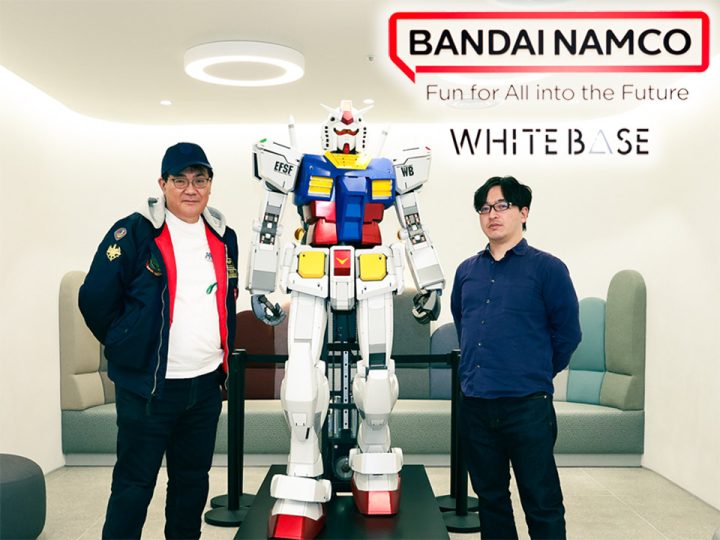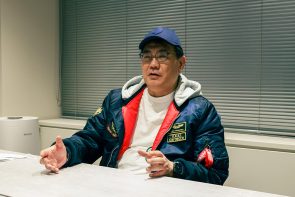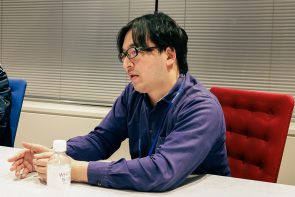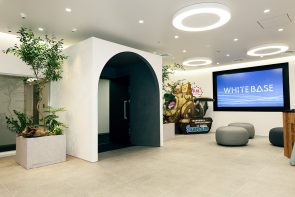
- Name:
- Bandai Namco Filmworks
- Profession:
- Animation Studio
- Web Site:
- https://en.gundam.info/ (external link)
BANDAI NAMCO FILMWORKS: INTERVIEW AT WHITE BASE
Well known for wildly popular anime such as the Gundam series and Love-Live! Series, Bandai Namco Filmworks Inc. has continued to live up to its legendary status and serve as a beacon of animation production in the Suginami ward of Tokyo, ever since the establishment of its predecessor, SUNRISE Inc.
Their anime works have garnered popularity overseas, and in particular the Gundam series became a symbol of Japanese robot/mecha anime with fans all over the world. On January 25, 2024, the day before the Japanese release of the new Bandai Namco Filmworks film “Mobile Suit Gundam SEED FREEDOM”, we at Experience Suginami Tokyo were honored to have an interview at their headquarters, Ogikubo “WHITE BASE”* in Suginami, Tokyo.
The first half of our Bandai Namco Filmworks interview was discussing the production of “Mobile Suit Gundam SEED FREEDOM” and its overseas audience with the film’s director, Mitsuo Fukuda, and producer, Toshikazu Naka. The second half covers the history of Bandai Namco Filmworks and its connection with Suginami, Tokyo, as discussed with the company’s operations and public relations staff, Rie Akutsu and Akane Hashidomi.
* WHITE BASE: the name of the mothership from the first Mobile Suit Gundam series.
1. About the Production of “Mobile Suit Gundam SEED FREEDOM”
Experience Suginami Tokyo (abbreviated as "EST" hereafter): First of all, congratulations on completing the new Gundam film! We are very honored to have this time to talk to you right before the movie’s release. So, at this moment just before release, do you feel anxious at all?
Toshikazu Naka (abbreviated as "TN" hereafter): Sure, I’m anxious and excited. How about you, director?
Mitsuo Fukuda (abbreviated as "MF" hereafter): Well, for me I felt more nervous before the film’s completion. As in, “I wonder if we’ll actually be able to finish it?”
EST: Could you tell us about the production of “Mobile Suit Gundam SEED FREEDOM”? Did the majority of the production take place right here at WHITE BASE?
TN: After establishing the plan and script of the film, the director draws the storyboards and then the artists and CG staff get to work on the project. The main team operates out of WHITE BASE in Ogikubo, but because a film like this is such a huge project that requires a lot of people to make, we also utilize production companies outside of our own. So that means we can’t possibly finish everything here at WHITE BASE. For sections of animation, we would also outsource some work abroad to companies in China and Malaysia.
MF: WHITE BASE is the control tower, so to speak. The planning and script are done by a small number of people, and there really isn’t anything like a meeting with a huge number of people to discuss them.
TN: Not only production, but also public relations and sales departments are based at WHITE BASE. There is also accounting and legal, and on top of the artwork I think these corporate functions are a very important side of the production process. I believe it is thanks to the support of those departments that we can create our works.
2. Regarding the Overseas Audience
EST: Is there anything you consider regarding the overseas audience when creating your works?
MF: Not really. I don’t think we’ve ever actually thought about that. To be frank, I don’t really know what the overseas audiences find so interesting about Japanese anime. Simply put, it’s made in the Japanese language, and as Japanese people we create our animated works with our own sense of values. So even though anime made here is created for Japan, I suppose people overseas feel something unique and interesting about it?
TN: Right. I mean, if you compare anime to Hollywood productions and such, the amount of people and money involved is much smaller, but perhaps what lacks in those aspects in Japanese anime is made up by the creator’s individual sense reflected in the work. That may be one of the characteristics of Japanese anime. We express what we find interesting in our own way, and because of that there might be a unique niche point of interest there.
EST: The theme of “war” is consistently dealt with in Gundam. What can you say about that?
TN: This is my personal opinion, but I think you are meant to feel how foolish the notions of domination and war are. The setting of “Mobile Suit Gundam SEED FREEDOM” is also a world devastated by ongoing war, but I think some part of that is satire of today’s actual world affairs.
MF: Japan has this, and it is common with religion as well, but as we accept various values, in part maybe there is some confusion between what’s right and what’s wrong.
That kind of approximation may only exist in Japan. Not to say that we approve of war, but sometimes we can’t often simply distinguish the difference between right and wrong. Taking Japanese anime as an example, as the target age group goes from child to adult, the narrative gradually changes from stories that reward good and punish evil to stories where both sides have their own righteous causes. With a rough sense of values that could accept either side, it might be a characteristic of Japan where we can freely make a creative work without control from the country. Because we’re an island nation, no matter how much globalization and interchange progresses around the world, I think there is a sense of values that are specifically rooted in Japan. If Japanese anime were to have any impact on the world, we must make use of this value system.
3. Production Hardships
EST: Were there some difficulties during production of the new Gundam film?
MF: Roughly, there were two things. First, completing the storyboard for the film was my personal hardship. Another hardship for me was keeping watch over all staff operations. The second one is a completely different kind of hardship from the first one. For my own personal hardship wrestling with the storyboards, I could always revise them as much as I felt necessary, but for the latter difficulty, if other members in production had a different view from my intention, I essentially had to accept it. Otherwise, we’d never finish in time! If you look at the end credits, I think you’d understand, but the amount of people involved in the production of a film like this is drastically more than a TV series and such, so it means there is just that much more thought that goes into it. The thoughts and desires of all of the production staff together complete the work, and a lot of labor goes into making that happen.
4. “Mobile Suit Gundam SEED FREEDOM” Opening Night
EST: Lastly, please share with us your current thoughts and emotions, prior to the film’s release.
TN: About 20 years have passed since the debut broadcast of “Mobile Suit Gundam SEED” as a TV anime series to the time the planning began for its adaption to film. During those 20 years, many people carried the responsibility of the desires and expectations they inherited for the series, so it is deeply moving to finally be able to unleash this film to the world.
MF: I hope people who see the movie will say it’s interesting. Moreover, I’ll be happy if they say it was worth the 20-year wait.
EST: We hope so, too. Thank you so much for talking with us!
The following portion of the interview was with Rie Akutsu and Akane Hashidomi, who are in charge of administrative planning and public relations at Bandai Namco Filmworks. We discussed the history of Bandai Namco Filmworks and its long connection with Suginami, Tokyo, as well as overseas operations.
5. About Bandai Namco Filmworks’ Start at SUNRISE
EST: Could you please go into the history of Bandai Namco Filmworks, back to its predecessor, SUNRISE?
Rie Akutsu (abbreviated as "RA" hereafter): The beginning of Bandai Namco Filmworks can be traced back to when Sunrise was started by former members of Mushi Production Co., Ltd., which was headed by Osamu Tezuka (manga artist famous for Astro Boy and others). In order for them to create their own animation works, they established Nippon Sunrise Co., Ltd. in November, 1976. From that time, the desire to freely create original animated works by their own hands was very strong. The main SUNRISE office was near Kami-Igusa Station in Suginami, and moved to its current location at “WHITE BASE” in Ogikubo, Suginami in 2021, when adopting the name “Bandai Namco Filmworks.” Around the time of SUNRISE’s establishment there were 2 studios, but there was a time when there were as many 11 studios being utilized near Kami-Igusa Station in Suginami.
EST: Among SUNRISE/Bandai Namco Filmworks’productions, of course the Gundam series is immensely popular, but did it gain a lot of popularity from the time it was first broadcast?
RA: Actually, it did not. Mobile Suit Gundam first aired in 1979. At the time, a simpler storyline of an evil enemy being beaten by a champion of justice was mainstream in robot/mecha anime. The human drama and the moral sense of both the enemies and allies portrayed in Gundam was a very unique perspective that was apparently not so easily accepted. The TV ratings were not really thriving.
EST: In other words, no one would have expected the Gundam series to become a worldwide success from the time it was first broadcast. What do you suppose it was that lit the spark to Gundam’s popularity?
RA: When the TV series was first broadcast it did not meet commercial success, but there were a number of fans that responded to its story, depth, and innovation. After the first series ended (43 episodes later in January, 1980), word of mouth gradually began to spread about the series, specifically amongst the young generation. Gundam’s popularity probably became acknowledged around the world with the reworked script of the TV series for a movie trilogy, with the first installment (“Mobile Gundam Suit I”) out in 1981. For a promotional event, director Yoshiyuki Tomino was invited to appear at the 2/22 Declaration of a New Anime Century event in Shinjuku, Tokyo, and it was big news at the time because over 15,000 fans showed up, exceeding all expectations. Another reason for the popularity increase was due to plastic model kits that were a growing fad among elementary and middle school aged children at the time.
EST: Thank you for the information. When did Gundam reach the level of popularity it is at now overseas?
RA: From the 1990s. The Gundam TV series that aired in Japan in 1995, “Mobile Suit Gundam Wing”, became the first series to be broadcast in North America. Later on from the 2000s with the steady spread of Internet media and streaming services, people around the world could enjoy Gundam with less of a wait after Japanese releases. For many years we hoped people overseas would also enjoy our anime works, and I think that hope was finally realized at last after around 20 years.
Akane Hashidomi (abbreviated as "AH" hereafter): Currently we have our official YouTube channel, Gundam Info (external link) and a variety of platforms abroad, so the amount of anime works you can enjoy without any time lag has also increased. Likely as a result of that, the response on social media and such from the overseas audience is exceedingly increasing.
EST: With reaction from overseas viewers in real time, has there been any change in attitude or thinking at Bandai Namco Filmworks?
RA: We are now creating works more on the basis that they will be watched by people from all over the world, each with their own set of values. We become more in tune to that when depicting gender or religion, and the way battle scenes are drawn, and so on.
EST: “Mobile Suit Gundam: The Witch from Mercury” was the first Gundam TV series to have a female protagonist, wasn’t it?
AH: Yes. However, without placing too much attention on the fact that she was a female character, the anime was created by taking care to depict her as a “human” character throughout the story.
6. Connection to Suginami, Tokyo, Area with the Most Anime Studios in Japan
EST: As both SUNRISE and the current Bandai Namco Filmworks WHITE BASE are located in Suginami, Tokyo, how do you feel about regional development activity through anime?
AH: As there are many regional representatives of Suginami who also enjoy our anime, we’re enjoying coming up with new projects.
EST: Going forward, what kind of exchange would Bandai Namco Filmworks like to have with the people of Suginami, Tokyo?
AH: At local events and such we’d love to establish an occasion for real exchange. Also, not just for Suginami, but also for schools all around the country, we are accepting career visits. Field trips to the actual location of anime production, with lectures about how anime is made from the producers and others— we’d also be delighted to have more opportunities for Suginami Schools to participate in such events.
EST: That sounds like a great opportunity! It would become an unforgettable experience for those kids.
AH: I really think so. In truth, for Bandai Namco Filmworks, we consider opportunities to have direct interaction with the young generation of viewers to be quite precious. At an event just the other day, the producer asked the children, “What anime are you watching now?” and so on. We’d really like to have more and more chances to have exchanges like that.
EST: Thanks to all of you at Bandai Namco Filmworks for your time and best of luck with the new release!
“Mobile Suit Gundam SEED FREEDOM” Overseas Opening Dates
(*please note these are subject to change)
February 8, 2024: Thailand
March 14, 2024: Australia and New Zealand
April 19, 2024: Taiwan
April 25, 2024: Hong Kong & Macau
“Mobile Suit Gundam SEED FREEDOM” Overseas Limited Screening Events
(*please note these are subject to change)
March 17, 23 & 24, 2024: UK & Ireland (select screening events only)
March 31, 2024: New York & Los Angeles, USA (select screening events only)
(USA event info external link)
[published March 2024]
Interviewer: Imagawa
Photographer: Kasamine
Director, Translator: G. Mudarri

Movie Poster for “Mobile Suit Gundam SEED FREEDOM”

“Mobile Suit Gundam SEED FREEDOM” Director Mitsuo Fukuda

“Mobile Suit Gundam SEED FREEDOM” Producer Toshikazu Naka

The lobby at Bandai Namco Filmworks main office, WHITE BASE in Ogikubo, Tokyo

CG animator at work on “Mobile Suit Gundam SEED FREEDOM”








